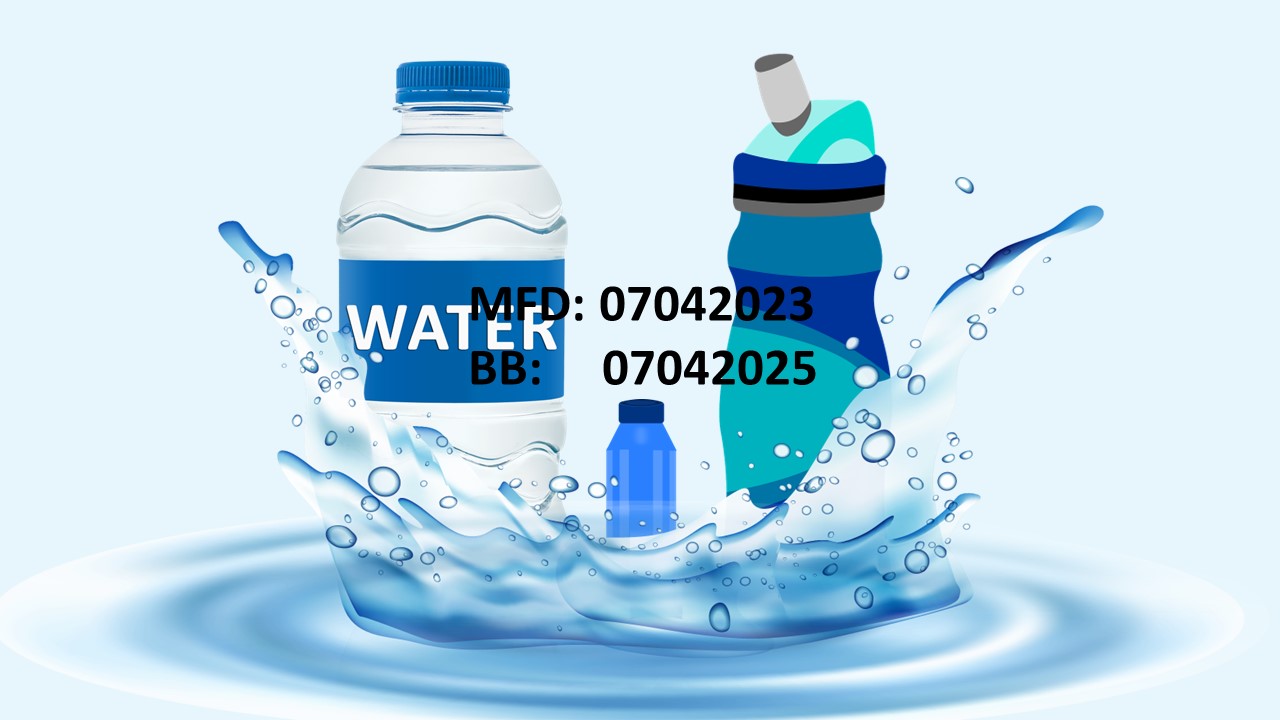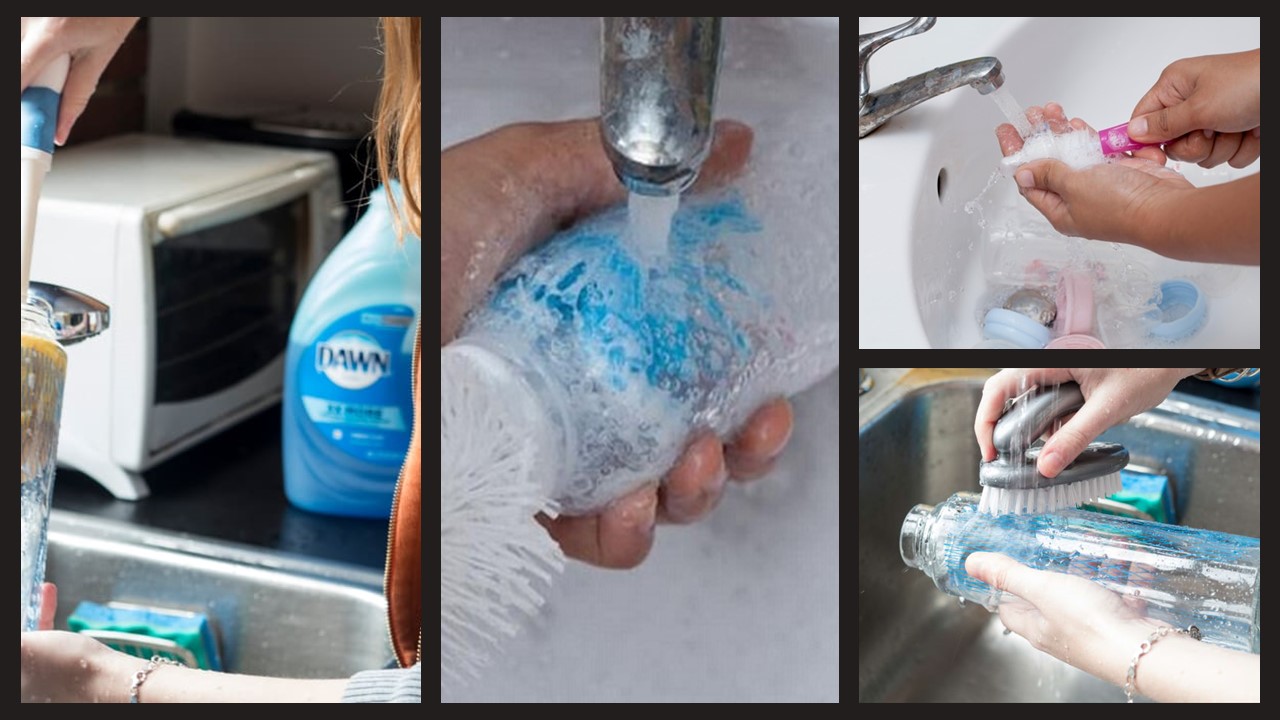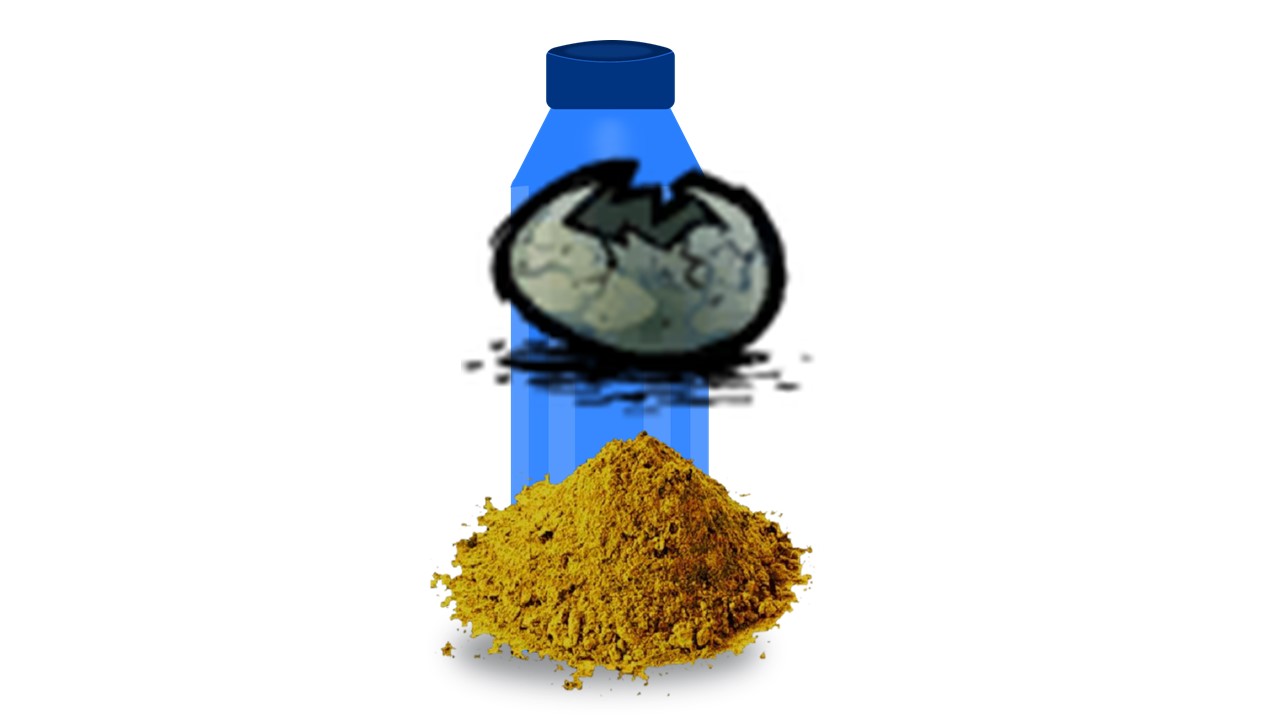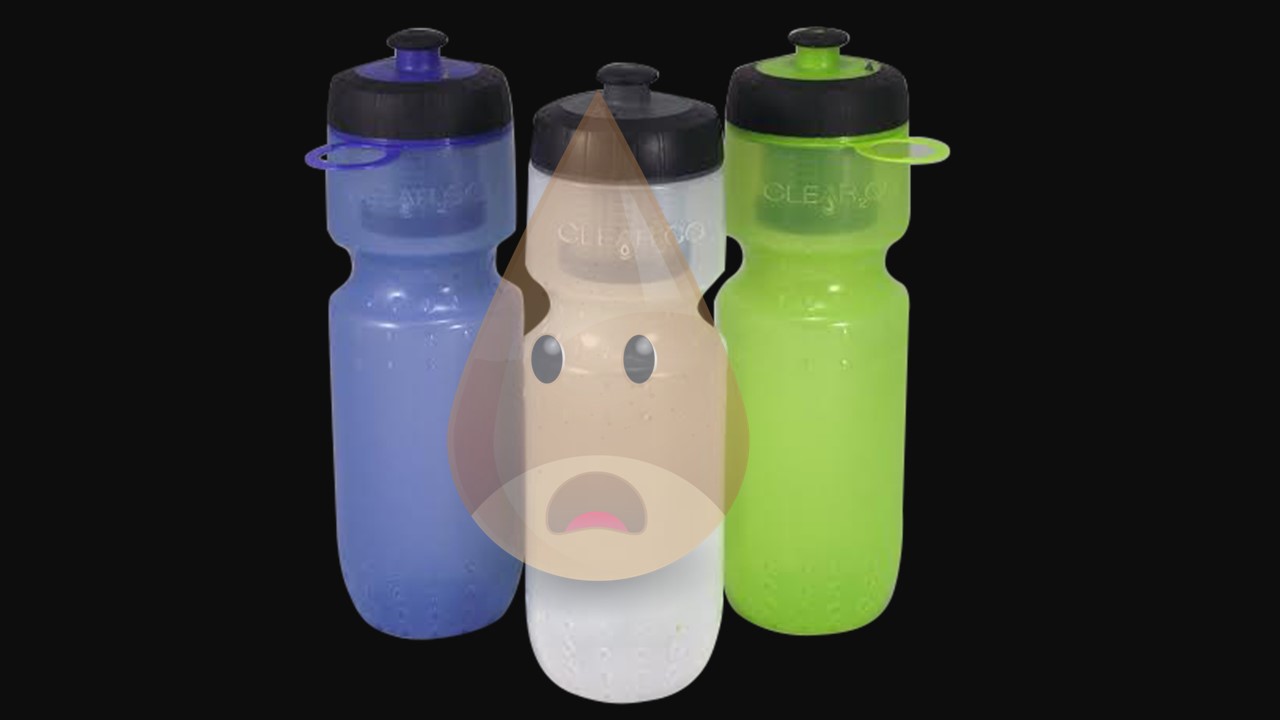Why Does My Water Bottle Smell Like Wet Dog – Unveiling The Danger And Solutions
Are you looking for an answer to “Why does my water bottle smell like wet dog?” Did you know that your water bottle can be a breeding ground for harmful bacteria and chemicals that can harm your health? Bacteria make your water bottle smell like wet dog.
But why should you be concerned about your water bottle smelling like wet dog? The truth is, when water is left in a bottle for an extended period, it can become a haven for bacteria growth, leading to potential health risks such as illness, infections, and even chemical leaching from certain bottle materials.
In this article, we’ll explore the causes of the wet dog smell in your water bottle, the health risks associated with it, and the best methods to clean and prevent the odor from recurring. We’ll also suggest some of the best water bottles on the market that are durable, easy to clean and don’t retain odor.
Why Does My Water Bottle Smell Like Wet Dog
There are several reasons why a water bottle may smell like a wet dog, including:
1. Bacteria Growth
When water or moisture is left in a bottle for an extended period, it creates a warm and damp environment that is conducive to bacterial growth. Bacteria feed on the organic matter found in water, such as minerals and nutrients, and produce waste products that give off an unpleasant odor.
If you use your bottle to drink sports drinks or beverages without cleaning it properly, it can encourage bacteria growth leading to an unpleasant smell.
2. Mold Formation
Like bacteria, mold thrives in warm and damp environments. If a water bottle is not cleaned regularly or left with water in it for too long, mold can grow and produce a smell like wet dog.
3. Contaminants In Water
Sometimes the water itself may contain contaminants that give off an unpleasant odor. For example, if the water has a high level of sulfur, it can produce an unpleasant smell.
4. Plastic Material
Some types of plastic used in making water bottles contain chemicals that can leach into the water and affect its taste and smell. Over time, the buildup of these chemicals can lead to a noticeable odor.
5. Poor Quality Water Bottle
Cheap and low-quality water bottles may not be designed to prevent bacterial or mold growth, leading to the development of an unpleasant odor.
6. Infrequent Cleaning
If a water bottle is not cleaned regularly, it can become a breeding ground for bacteria and mold, leading to a foul odor. Even if you clean the bottle regularly but not cleaned it properly, it can still smell.
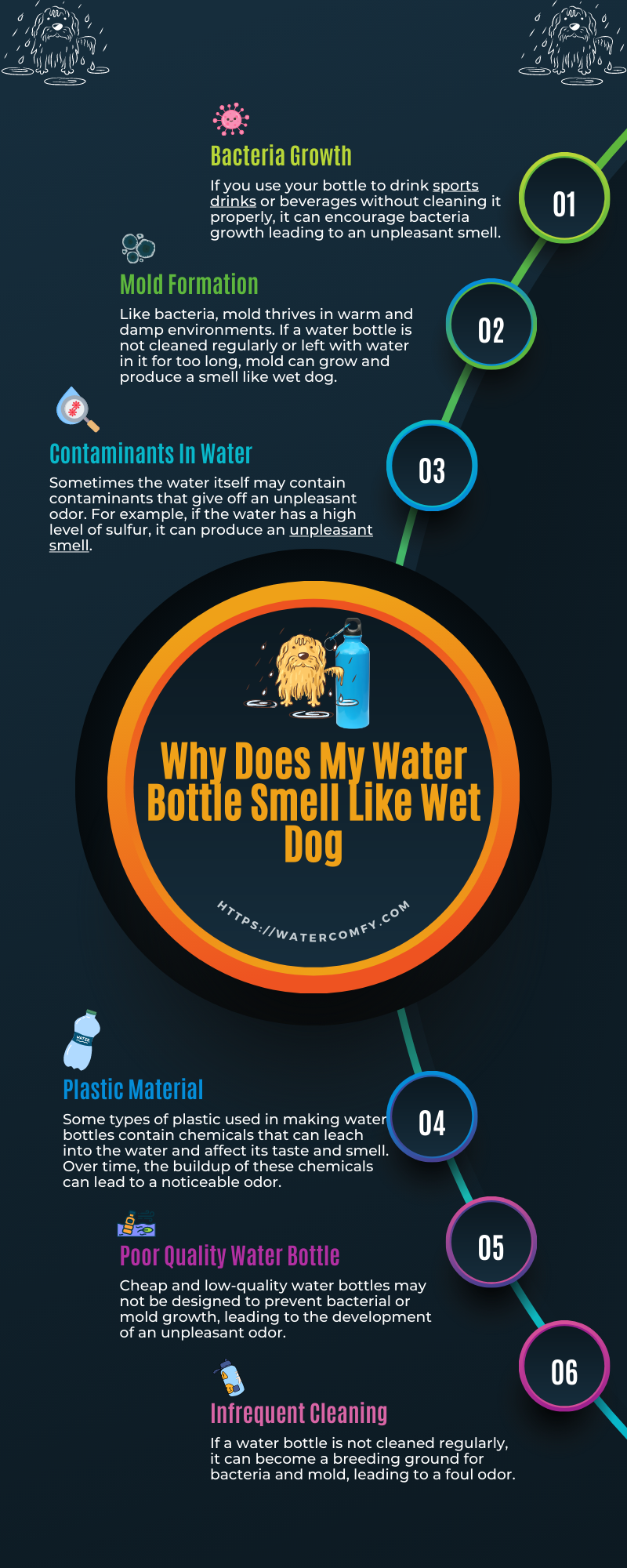
Science Behind Water Bottle Smelling Like Wet Dog
The science behind why a water bottle may smell like a wet dog is quite straightforward. The odor is usually caused by bacteria growth or mold formation in the bottle. When water is left in a bottle for an extended period, it creates a damp and warm environment that is conducive to bacterial growth.
Bacteria feed on the organic matter found in water bottles, such as minerals and nutrients, and produce waste products that give off an unpleasant odor. If you especially use your water bottle to drink sports drinks or other beverages, your bottle will be susceptible to a foul smell.
Additionally, the materials used to make the water bottle can also contribute to the odor. Some types of plastic, for instance, contain chemicals that can leach into the water and affect its taste and smell. Over time, the buildup of these chemicals can lead to a noticeable odor, similar to that of a wet dog.
Moreover, the growth of mold in a water bottle can also cause an unpleasant odor. Mold thrives in warm and damp environments, and if a water bottle is not cleaned regularly or left with water in it for too long, mold can grow and produce a musty smell.
Why Does My Water Bottle Smell Like Wet Dog – Health Implications
Drinking from a water bottle that has a foul smell can pose potential health risks due to the growth of harmful bacteria or the ingestion of chemicals from the plastic. Here are some of the health risks associated with drinking from a contaminated water bottle:
1. Risk of bacterial infection: When water is left in a bottle for too long, it creates a warm and damp environment that is perfect for bacterial growth.
Drinking from a contaminated water bottle can expose you to harmful bacteria such as E. coli, salmonella, and listeria, which can cause diarrhea, vomiting, fever, and even more severe infections.
2. Risk of mold exposure: Mold thrives in warm and damp environments, and if a water bottle is not cleaned regularly or left with water in it for too long, mold can grow and produce a bad smell. Inhaling mold spores can lead to respiratory problems, allergic reactions, and other health issues.
3. Risk of chemical leaching: Some types of plastic used in making water bottles contain harmful chemicals such as bisphenol A (BPA), phthalates, and antimony. These chemicals can leach into the water and cause hormonal imbalances, reproductive issues, and other health problems.
4. Risk of dehydration: If you are not drinking enough water because of the unpleasant smell from your water bottle, you may become dehydrated. Dehydration can cause fatigue, headaches, dizziness, and other health issues.
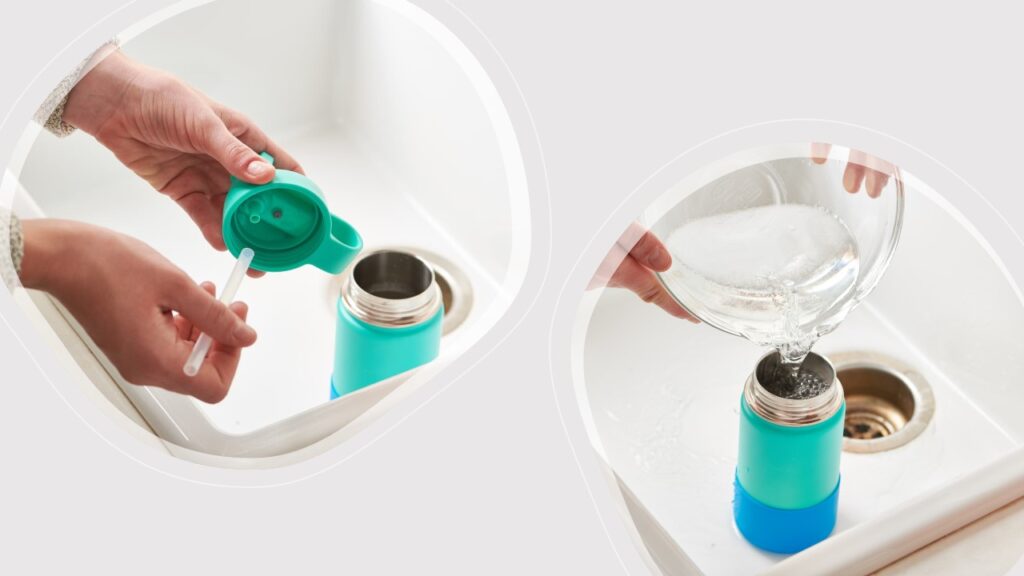
How To Clean Water Bottles That Smell Like Wet Dog (Why Does My Water Bottle Smell Like Wet Dog)
Cleaning a water bottle that smells like a wet dog can be challenging, but with the right cleaning techniques, it can be easy to eliminate the odor. Here are some tips for cleaning a smelly water bottle:
1. Baking Soda And Vinegar Solution
Mix 1 2/3 cups of baking soda and 2 tablespoons of white vinegar with ½ cup of liquid soap to create a cleaning solution. Dilute the mixture with ½ cup of water. Pour the solution into the water bottle and let it sit for 10-15 minutes. Shake it vigorously. You can also use a brush to scrub the bottle.
Rinse the bottle thoroughly with hot water and let it dry completely. Baking soda and vinegar are natural deodorizers that can help eliminate the wet dog odor.
2. Use A Specialized Cleaning Product
There are several specialized cleaning products available in the market that are designed to eliminate the odor from water bottles. Follow the instructions on the label to use the product effectively.
3. Lemon Juice And Hot Water
Fill the water bottle with hot water and add some lemon juice. Let the solution sit for a few minutes before shaking the bottle vigorously and rinsing the bottle with hot water. The citric acid in lemon juice can help eliminate the odor.
4. Dish Soap And Hot Water
Add a few drops of dish soap to hot water and pour the solution into the water bottle. Use a bottle brush to scrub the inside of the bottle thoroughly, paying special attention to the crevices and corners. Rinse the bottle with hot water and let it dry completely.
5. Hydrogen Peroxide And Baking Soda
Mix equal parts of hydrogen peroxide and baking soda with a gallon of water. Pour the mixture in the water bottle and let it sit for a few minutes (5 to 15 minutes). Shake vigorously. Scrub the inside of the bottle with a bottle brush, and then rinse the bottle thoroughly with hot water. Let it air dry.
How To Prevent Water Bottles From Smelling Like Wet Dog
To prevent the wet dog odor from recurring in your water bottle, there are some simple preventative measures that you can take. Here are some tips:
1. Wash The Water Bottle Regularly
Cleaning the water bottle regularly is the key to keeping it free from odors. Ideally, you should clean the water bottle after each use with hot soapy water, paying special attention to the crevices and corners. You can also use a bottle brush to scrub the inside of the bottle thoroughly.
2. Avoid Leaving Water In The Bottle For Extended Periods
Leaving water in the bottle for an extended period can create a warm and damp environment that is perfect for bacterial growth and mold formation. Empty the water bottle when you are not using it and refill it with fresh water when you need it.
3. Store The Bottle In A Dry Place
Moisture is the enemy of a clean water bottle. Store the bottle in a dry place, away from sunlight and heat. Make sure the bottle is completely dry before storing it, to prevent the growth of mold or bacteria.
4. Use A High-Quality Water Bottle
Choosing a high-quality water bottle can make a big difference in preventing odors. Look for bottles made of materials that are less prone to bacterial growth and mold formation, such as stainless steel or glass.
5. Use Filtered Water
Using filtered water can help reduce the risk of bacterial growth and chemical leaching, which can contribute to foul odors. Invest in a good water filter or purchase pre-filtered water.
Best Water Bottles For Odor Control
Product Image | Product Name | Key Features | Rating | Price |
| ||||
| ||||
| ||||
| ||||
| ||||
| ||||
| ||||
| ||||
| ||||
|
If you’re in the market for a new water bottle and want to ensure that it doesn’t retain odor, here are some of the best water bottles for odor control:
1. Stainless Steel Water Bottles: Stainless steel water bottles are easy to clean, durable, and don’t retain odor. They’re also free from BPA and other harmful chemicals. Some popular brands of stainless steel water bottles include Contigo, Hydro Flask, IRON FLASK and Takeya.
2. Glass Water Bottles: Glass water bottles are another great option for odor control. They don’t retain odor, are easy to clean, and are free from harmful chemicals. Some popular brands of glass water bottles include Chef’s Star, EPICA, PURIFYOU and Contigo.
3. Tritan Water Bottles: Tritan water bottles are made of a type of material that is free from BPA and other harmful chemicals. They’re also durable and easy to clean. Some popular brands of Tritan water bottles include Takeya, Contigo, Nalgene and CamelBak.
4. Silicone Water Bottles: Silicone water bottles are lightweight, durable, and easy to clean. They’re also free from harmful chemicals and don’t retain odor. Some popular brands of silicone water bottles include DEARAY and Hydrapak.
5. Collapsible Water Bottles: Collapsible water bottles are a great option for those who are short on space. They’re easy to clean, don’t retain odor, and can be flattened and stored when not in use. Some popular brands of collapsible water bottles include Normader, Platypus, PROOS and Vapur.

How To Avoid Getting Sick From A Smelly Water Bottle (Why Does My Water Bottle Smell Like Wet Dog)
To avoid getting sick from a smelly water bottle, follow these preventive measures:
- Regular Cleaning: Clean your water bottle thoroughly after each use. Use hot soapy water and a bottle brush to reach all corners. Rinse it well with clean water afterward.
- Air Drying: Allow your water bottle to air dry completely after washing. Bacteria thrive in damp environments, so make sure the bottle is dry before sealing it.
- Avoid Storing Liquids for Extended Periods: Don’t leave liquids sitting in your water bottle for too long, especially in warm or humid conditions, as it can promote bacterial growth and cause foul odors.
- Choose the Right Material: Opt for water bottles made of materials less likely to retain smells, such as stainless steel or glass, instead of plastic.
- Use Odor-Resistant Bottles: Consider investing in a water bottle with odor-resistant features or coatings designed to prevent bacteria and odor buildup.
- Avoid Adding Strong-Scented Liquids: Refrain from putting strongly scented liquids (e.g., coffee, juice) in your water bottle, as their residual smell can linger and affect the taste of water.
- Regular Replacement: Replace your water bottle periodically, especially if it starts to develop persistent odors even after cleaning.
- Keep Bottle and Cap Separate during Storage: Allow both the bottle and cap to air out separately when not in use. This reduces the chances of trapped moisture that can lead to odors.
- Store in a Cool, Dry Place: Avoid leaving your water bottle in hot or humid environments, as this can create an ideal breeding ground for bacteria.
- Avoid Sharing Your Bottle: Sharing water bottles can transfer bacteria and germs, increasing the risk of contamination.
- Don’t Touch the Inside of the Bottle: Try to avoid touching the inside of the bottle with your hands or any other objects to reduce the transfer of germs.
- Use a Bottle with a Wide Mouth: Bottles with wide mouths are easier to clean thoroughly, preventing hidden pockets of bacteria.
- Clean Bottle Caps and Straws: Pay attention to cleaning bottle caps, straws, or any other removable parts that come in contact with your drink.
- Inspect for Mold or Residue: Regularly check the interior of the bottle for any signs of mold, stains, or residue. If you notice any, clean the bottle immediately.
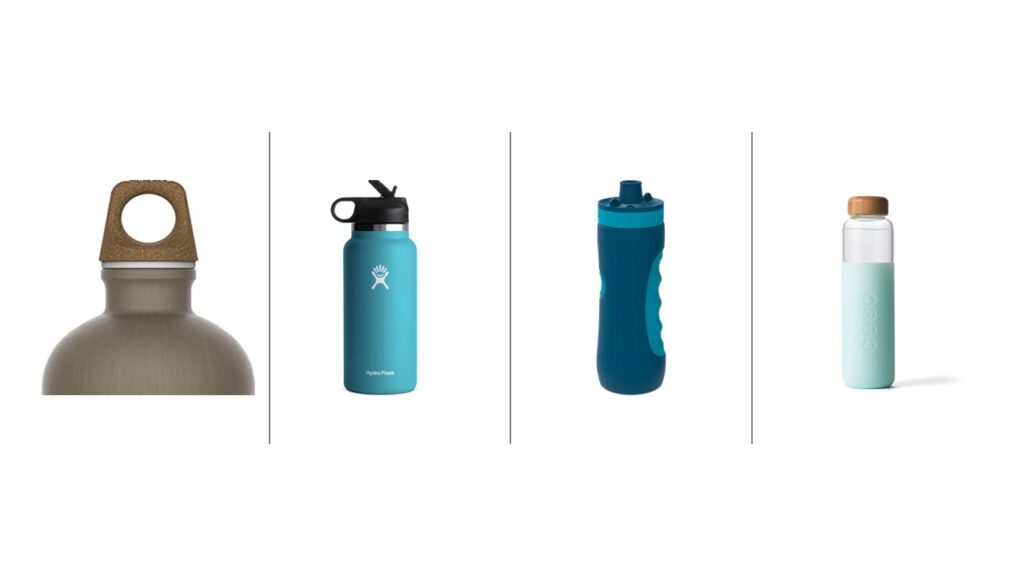
Choosing The Right Water Bottle Material (Why Does My Water Bottle Smell Like Wet Dog)
Selecting the right water bottle material is crucial for various reasons, including durability, safety, and environmental impact. Here are some common water bottle materials along with their characteristics:
1. Stainless Steel
Pros: Durable, resistant to rust and corrosion, does not retain or impart flavors, and keeps liquids cold or hot for extended periods.
Cons: Can be heavier than other materials, and some models may dent if dropped.
2. Plastic (BPA-Free)
Pros: Lightweight, affordable, and available in a wide range of designs and colors. BPA-free plastic eliminates exposure to harmful chemicals like Bisphenol-A.
Cons: Prone to scratches and can retain odors and flavors if not cleaned properly. May not retain temperature as effectively as stainless steel.
3. Glass
Pros: Doesn’t retain flavors or odors, environmentally friendly, and provides a pure taste. It is easy to clean and is free from harmful chemicals.
Cons: Fragile and can break if dropped, making it less suitable for certain activities like hiking or sports.
4. Aluminum
Pros: Lightweight, recyclable, and can keep liquids cool. Some models come with an interior coating that prevents the liquid from contacting the metal.
Cons: Aluminum bottles can scratch or dent, and some users might be concerned about potential leaching of metals into beverages.
5. Copper (with Inner Lining)
Pros: Known for its antimicrobial properties, which can help prevent bacterial growth. Copper can also keep water naturally cool.
Cons: Copper can react with certain liquids, so copper bottles often have an inner lining to prevent direct contact.
6. Titanium
Pros: Extremely lightweight, strong, and durable. Resistant to corrosion and does not affect the taste of liquids.
Cons: Expensive compared to other materials and may not be widely available.
7. Silicone
Pros: Collapsible and easy to store when empty. BPA-free and lightweight.
Cons: Not as durable as other materials, and some users might not like the feel of silicone.
When choosing a water bottle material, consider your exact needs and preferences. If you prioritize durability and temperature retention, stainless steel or insulated options might be best.
If environmental impact is essential, opt for glass or BPA-free plastic. Additionally, pay attention to features like leak-proof lids, wide-mouth openings for easy cleaning, and overall design to ensure the bottle suits your lifestyle and activities.
Best Practices For Storing Water Bottles (Why Does My Water Bottle Smell Like Wet Dog)
Properly storing water bottles is essential to maintain their cleanliness, prevent odors, and ensure safe drinking water. Here are some best practices for storing water bottles:
- Clean Before Storage: Always clean your water bottle thoroughly before storing it. Use hot, soapy water and a bottle brush to reach all corners. Rinse it well with clean water afterward.
- Completely Dry the Bottle: Ensure the water bottle is completely dry before storing it. Bacteria flourish in damp environments, so drying the bottle thoroughly helps prevent mold and mildew growth.
- Store with the Cap Off: Store your water bottle with the cap off or partially unscrewed. This allows air circulation, reducing the chances of trapped moisture and foul odors.
- Keep Bottles in a Cool, Dry Place: Choose a cool and dry location for storing water bottles. Avoid storing them in direct sunlight or places with high humidity, as these conditions can promote bacterial growth and affect the taste of the water.
- Avoid Storing Near Chemicals or Strong Odors: Keep water bottles away from strong-smelling substances or chemicals to prevent the transfer of odors to the bottle.
- Use a Cupboard or Storage Rack: Consider using a cupboard or a dedicated storage rack to keep your water bottles organized and free from potential contaminants.
- Keep Bottles Separated: If you’re storing multiple water bottles, make sure to keep them separated to prevent scratching or damage. You can use dividers or soft cloth material between bottles to provide a cushion.
- Check for Damage or Wear: Regularly inspect your water bottles for signs of wear, damage, or cracks. Damaged bottles may not be safe for storing water and should be replaced.
- Store in an Upright Position: Store water bottles in an upright position to minimize the risk of leaking. If you need to store bottles horizontally, ensure they have a reliable and leak-proof sealing mechanism.
- Avoid Stacking When Filled: Avoid stacking water bottles on top of each other when they are filled with liquid to prevent potential leaks or spills.
- Keep in Mind Expiration Dates: If your water bottles have expiration dates (e.g., for insulated bottles), pay attention to them and replace bottles if needed.
- Rotate Water Bottles Regularly: If you have multiple water bottles, consider rotating their use regularly to ensure all bottles get equal cleaning and usage.
FAQs About Why Does My Water Bottle Smell Like Wet Dog
1. Why Does My Water Bottle Smell Bad Even After Washing It?
The lingering smell in your water bottle could be due to bacteria or mold that survived the washing process. Make sure to clean your water bottle thoroughly with hot soapy water and use a bottle brush to reach all corners. Allow the bottle to air dry completely before sealing it to prevent bacterial growth.
2. Can A Smelly Water Bottle Make Me Sick?
Yes, a smelly water bottle can potentially make you sick. Bacteria and mold that cause foul odors can also contaminate your drinking water, leading to health issues. It’s essential to maintain a clean and odor-free water bottle to ensure safe hydration.
3. How Often Should I Clean My Water Bottle To Avoid Odors?
To prevent odors and bacterial buildup, it’s recommended to clean your water bottle after each use. Regularly washing with hot soapy water and thorough drying will help maintain a clean and fresh-smelling bottle.
4. What’s The Best Way To Clean A Smelly Water Bottle?
Cleaning a smelly water bottle involves using hot, soapy water and a bottle brush to scrub the interior thoroughly. Rinse the bottle well with clean water and allow it to air dry completely before storing. If it is still smelly, wash it with baking soda or white vinegar.
5. Can I Use Bleach To Clean My Water Bottle And Remove The Smell?
It’s not advisable to use bleach to clean a water bottle, as it can leave harmful residues and affect the taste of water. Stick to using hot soapy water or natural cleaning solutions like vinegar or baking soda.
6. How Can I Prevent My Water Bottle From Developing A Smell In The First Place?
To prevent odors, ensure you clean and dry your water bottle properly after each use. Avoid storing liquids in the bottle for extended periods, and choose materials like stainless steel or glass, which are less likely to retain smells.
7. Can I Use Lemon Or Citrus-Infused Water In My Bottle Without Causing A Smell?
While using lemon or citrus-infused water can add flavor, it may leave behind residual smells if not cleaned thoroughly. Make sure to clean your water bottle promptly after using flavored water to prevent odors.
8. How Do I Get Rid Of The Smell In My Water Bottle If It’s Already Present?
To remove existing smells, try washing the bottle with a mixture of warm water and baking soda. You can also use a solution of white vinegar and water. Allow the solution to sit in the bottle for some time before rinsing thoroughly with clean water.
9. Are There Specific Water Bottle Materials Less Prone To Retaining Odors?
Yes, materials like stainless steel and glass are less likely to retain odors compared to plastic bottles. Stainless steel, in particular, is known for its odor-resistant properties.
10. Can I Use Dishwashers To Clean My Water Bottle?
While some water bottles are labeled as dishwasher-safe, it’s best to check the manufacturer’s instructions. Hand washing with hot, soapy water and a bottle brush is generally the safest method to prevent damage or deterioration of the bottle.
The Bottom Line On Why Does My Water Bottle Smell Like Wet Dog
I have provided answers to the question “why does my water bottle smell like wet dog?” including the health risk and everything you should know. A foul-smelling water bottle can be a breeding ground for harmful bacteria and pose health risks.
However, by taking simple preventative measures such as regular cleaning, proper storage, and investing in high-quality, odor-resistant water bottles, you can ensure that your water stays fresh and safe to drink.
Don’t let a smelly water bottle hold you back from staying hydrated and healthy – act today to keep your water bottle clean and odor-free.










